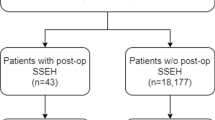Abstract
Background
Spontaneous spinal epidural hematoma (SSEDH) is a rare condition with potentially devastating consequences. Known prognostic factors are short time to surgery, preoperative neurologic condition, and age. The aim of this study was to investigate the impact of the transversal hematoma extent with its subsequent spinal canal obliteration on outcome in patients with SSEDH.
Methods
A retrospective study including all patients that underwent surgery due to SSEDH at the University Hospital of St. Poelten between 1/7/2005 and 30/6/2020 was conducted. The percentage of spinal canal obliteration at the level where the hematoma was most prominent was calculated and correlated to functional outcome.
Results
A total of 17 patients could be included in this study. Preoperative ASIA impairment scale showed positive correlation with postoperative outcome (p = 0.005). Patients with a favorable outcome (ASIA D and E) showed a statistically significant lower mean obliteration of the spinal canal by the hematoma with 46.4% (± 8%) in comparison to patients with an unfavorable outcome with 62.1% (± 6%, p = 0.001). A cut-off of 51% yielded a sensitivity and specificity for favorable outcome of 100% and 70% respectively (area under the ROC 0.93, p < 0.001).
Conclusion
Preoperative percentage of spinal canal obliteration is statistically significant lower in patients with favorable outcome in surgically treated patients with spontaneous spinal epidural hematoma.





Similar content being viewed by others
Data availability
The datasets analyzed during the current study are available from the corresponding author on reasonable request.
Abbreviations
- SSEDH:
-
: Spontaneous spinal epidural hematoma
- ASIA:
-
: American Spinal Injury Association impairment scale
References
Bakker NA, Veeger NJGM, Vergeer RA, Groen RJM (2015) Prognosis after spinal cord and cauda compression in spontaneous spinal epidural hematomas. Neurology 84(18):1894–1903
Börm W, Mohr K, Hassepass U, Richter HP, Kast E (2004) Spinal hematoma unrelated to previous surgery: analysis of 15 consecutive cases treated in a single institution within a 10-year period. Spine (Phila Pa 1976) 29(24):555–561
Fedor M, Kim ES, Ding K, Muizelaar JP, Kim KD (2011) Spontaneous spinal epidural hematoma: a retrospective study on prognostic factors and review of the literature. Korean J Spine 8(4):272
Figueroa J, DeVine JG (2017) Spontaneous spinal epidural hematoma: literature review. J Spine Surg 3(1):58–63
Groen RJM, Goffin J (2004) Non-operative treatment of spontaneous spinal epidural hematomas: a review of the literature and a comparison with operative cases. Acta Neurochir (Wien) 146(2):103–110
Groen RJM, Ponssen H (1990) The spontaneous spinal epidural hematoma. A study of the etiology. J Neurol Sci 98(2–3):121–138
Heppner PA, Monteith SJ, Law AJJ (2009) Spontaneous spinal hematomas and low-molecular-weight heparin. J Neurosurg Spine 1(2):232–236
Kreppel D, Antoniadis G, Seeling W (2003) Spinal hematoma: a literature survey with meta-analysis of 613 patients. Neurosurg Rev 26(1):1–49
Mukerji N, Todd N (2013) Spinal epidural haematoma; factors influencing outcome. Br J Neurosurg 27(6):712–717
Raasck K, Habis AA, Aoude A, Simões L, Barros F, Reindl R, Jarzem P (2017) Spontaneous spinal epidural hematoma management: a case series and literature review. Spinal Cord Ser Cases 3(1):1–6
Sawin PD, Traynelis VC, Follett KA (1995) Spinal epidural hematoma following coronary thrombolysis with tissue plasminogen activator Report of two cases. J Neurosurg 83(2):350–353
Yu JX, Liu J, He C et al (2017) Spontaneous spinal epidural hematoma: a study of 55 cases focused on the etiology and treatment strategy. World Neurosurg 98:546–554
Acknowledgements
The authors want to appreciate the contribution of NÖ Landesgesundheitsagentur, legal entity of University Hospitals in Lower Austria, for providing the organizational framework to conduct this research.
Author information
Authors and Affiliations
Contributions
Conception and design: Scheichel. Acquisition of data: Scheichel, Marhold, Berger-Brabec. Analysis and interpretation of data: Marhold, Scheichel. Drafting the article: Marhold, Popadic, Scheichel. Critically revising the article: Marhold, Scheichel, Popadic, Rechberger, Berger-Brabec, Decristoforo, Sherif. Reviewed submitted version of manuscript: Marhold, Scheichel. Approved the final version of the manuscript on behalf of all authors: Marhold, Scheichel. Statistical analysis: Scheichel. Study supervision: Marhold, Scheichel.
Corresponding author
Ethics declarations
Ethical Approval
This retrospective study was approved by the Ethics Committee of the Karl Landsteiner University of Health Sciences, Krems, Austria, approval no.: 1056/2020. The study was conducted in accordance with the ethical standards of our institutional and national research committee and with the 1964 Helsinki declaration and its later amendments or comparable ethical standards.
Conflict of interest
The authors declare no competing interests.
Additional information
Publisher's note
Springer Nature remains neutral with regard to jurisdictional claims in published maps and institutional affiliations.
This article is part of the Topical Collection on Spine - Other
Rights and permissions
About this article
Cite this article
Marhold, F., Popadic, B., Rechberger, P. et al. Extent of spinal canal obliteration as prognostic factor for functional outcome in patients with spontaneous spinal epidural hematoma: a retrospective study. Acta Neurochir 163, 3279–3286 (2021). https://doi.org/10.1007/s00701-021-05011-x
Received:
Accepted:
Published:
Issue Date:
DOI: https://doi.org/10.1007/s00701-021-05011-x




